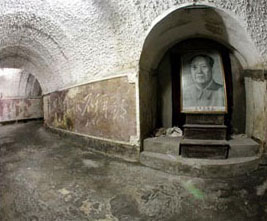
For more than 20 years, Beijing’s Underground City, a bomb shelter just beneath the ancient capital’s downtown area, has been virtually forgotten by local citizens, despite being well-known amongst foreigners since it officially opened in 2000.
The Underground City has also been called the Underground Great Wall, since they had the same purpose: military defense.
This complex is a relic of the Sino-Soviet border conflict in 1969 over Zhenbao Island in northeast China’s Heilongjiang River, a time when chairman Mao Zedong ordered the construction of subterranean bomb shelters in case of nuclear attack.
The tunnels, built from 1969 to 1979 by more than 300,000 local citizens and even school children, wind for over 30 kilometers and cover an area of 85 square kilometers eight to eighteen meters under the surface. It includes around a thousand anti-air raid structures.
To supply construction materials for the complex, centuries-old city walls and towers that once circled ancient Beijing were destroyed. The old city gates of Xizhimen, Fuchengmen, Chongwenmen and others remain in name only – only two embrasured watchtowers from Zhengyangmen and Deshengmen survived.
In the event of attack, the plan was to house forty percent of the capital’s population underground and for the remainder to move to neighboring hills, and it is said that every residence once had a secret trapdoor nearby leading to the tunnels.
There is no authoritative information on how far the mostly hand-dug tunnels stretch, but they supposedly link all areas of central Beijing, from Xidan and Xuanwumen to Qianmen and Chongwen districts, to as far as the Western Hills.
They were equipped with facilities such as stores, restaurants, clinics, schools, theaters, reading rooms, factories, a roller skating rink, a grain and oil warehouse as well as barber shops and a mushroom cultivation farm, for growing foods that require little light.
Over 2,300 elaborate ventilation shafts were installed, and gas and waterproof hatches constructed to protect insiders from chemical attack and radioactive fallout. There are also more than 70 sites inside the tunnels to dig wells.
Mao’s slogan calling for people to dig deep, prepare provisions and not to seek hegemony is printed on the wall.
Of course, the underground city was thankfully never needed for its intended purpose, but it has been maintained by city officials. Water conservancy authorities check it every year during rainy season, and it is included in anti-vermin sweeps.
The tunnels have since been used by young lovers, and by children daring each other to remain in the darkness longer than their friends. But they were largely shut off for safety reasons.
On busy streets, some shelters are now used as low priced hostels, while others have been transformed into shopping and business centers, or even theaters.
Despite having so many entrances, foreign visitors usually see a small approved section accessed via a small shop front in Qianmen, south of Tiananmen.
Travel tips:
Tour groups can enter free of charge without prior permission, whilst individual tourists are charged 20 yuan (US$2.4).
For those interested in seeing the Underground City, the address is 62 West Damochang Street, Qianmen, tel. 6702-2657. Apparently, there is another site in Beijing Qianmen Carpet Factory at 44 Xingfu Dajie, Chongwen District, tel. 6701-5079 and a lesser known one at 18 Dazhalan Jie in Qianmen.
(China.org.cn by Wang Zhiyong April 15, 2005)
|

